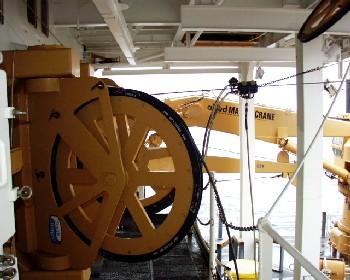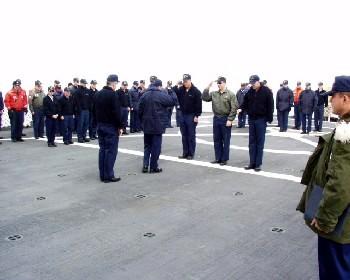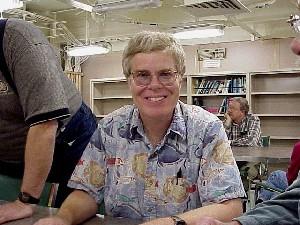
|
|
27 June, 2000
Tuesday, June 27, 2000
Chief Scientist James H. Swift

Picture 2 Dr. Swift pointed out that with any new ship, there are going to be many little problems that need to be worked out. After the Healy has made it to Seattle, these problems will be addressed and work will be done over a period of six to seven months to rectify them. The biggest concern Dr. Swift has is with the winch control system. The winch system is the most crucial piece of hardware for science research on the Healy. It is responsible for raising and lowering equipment over the side of the ship. Just on this cruise alone, we have seen the winch system used over and over for coring, mooring, and dredging. Possible problems could arise with the winch system or with slack wire, especially when the ship is experiencing rolling conditions. This could lead to the wire "jumping the sheave", the large wheel-like pulley pictured above. The wire could be pinched to the point it breaks, causing the loss of the science equipment on the other end. And obviously, this could cause serious safety issues for the crew at work. Dr. Swift identified many positive aspects of the Healy. All of the basic science systems are working well. He is especially pleased with how well the SEABEAM sonar equipment has worked. He has never seen better results for this system on a new ship. Many changes were made following the first phase of testing in February. These changes have gotten the SEABEAM to this point. He also pointed out how the communication system on board has lead to a quieter ship. A pager system has cut down on the need for piping messages all over the ship. When work is being done around the clock, and sleep schedules vary throughout the day, this will be helpful in having a well-rested crew.

Picture 3 Dr. Swift was also quick to point out how well the crew performed throughout legs three and four. He has observed first class science and deck operations. He commended Captain Jeffery Garrett for how well the crew has been prepared. In Dr. Swift's own words, "The Healy is going to be a famous research vessel." The word has already gotten out that the Healy is indeed going to be a premier vessel for scientific research. Scientists put in their proposals for conducting research on the Healy for the year 2001 back in February. The National Science Foundation is now in the process of completing a multi-level review of the proposals. When the proposals are awarded, the U.S. Coast Guard and the NSF will jointly handle scheduling for the research cruises picked.

Picture 1 Dr. James A. Swift I had the opportunity to sit down with James H. Swift, the Chief Scientist for Phase IV, Legs 3 and 4 of the ice trials. Dr. James Swift also chairs the Arctic Icebreaker Coordinating Committee, or AICC, which was formed in 1996. The committee has played an important role in advising the Coast Guard and modifying the science work areas on the Healy. I wanted to get his views on how well the ship and its crew performed during over the past three weeks.
Contact the TEA in the field at
.
If you cannot connect through your browser, copy the
TEA's e-mail address in the "To:" line of
your favorite e-mail package.
|
